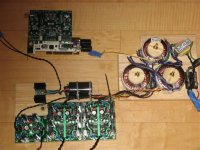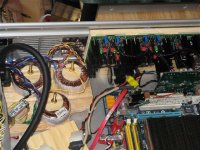RussThree things,
One - mathematically you would not need 100mhz (you would only need about 68mhz) to get 352.8khz (assuming you use I2S) 80mhz should be more than enough.
Two - 100mhz is at the very maximum for the master clock.
Three - I am not sure that the OSF on the ES9018 will correctly handle 352.8khz sampled data. You would probably have to run in OSF bypass mode. I am not sure on this though
Maybe Dustin could chime in.
In short I personally would not recommend a 100mhz clock.
Cheers!
Russ
Mr Bunpei from
http://www.diyaudio.com/forums/digi...ry-card-transport-project-10.html#post2068079
write:
A plain SDTrans192 is capable of playing 352.8 kHz / 24 bit WAV files using
on I2S interface.
No options are required.
We are not sure that Twisted Pear Audio Buffalo II DAC supports 352.8 kHz /
24 bit I2S play or not.
Our concern is a processor clock frequency for ES9018.
In the case of ESS ES9018 2ch Evaluation Board, 80 MHz clock was not enough
for a stable play.
An oscillator of 100 MHz was necessary according to our experience.
We guess Buffalo II DAC may have 80 MHz oscillator.
Would you please ask Twisted Pear people about this?
Can you confirm that?
Best regards
It is the result of 2 years research and development.
Surely you need at the very minimum, 4 1/2 years of R&D for it to be worth writing about
Russ
Mr Bunpei from
http://www.diyaudio.com/forums/digi...ry-card-transport-project-10.html#post2068079
write:
A plain SDTrans192 is capable of playing 352.8 kHz / 24 bit WAV files using
on I2S interface.
No options are required.
We are not sure that Twisted Pear Audio Buffalo II DAC supports 352.8 kHz /
24 bit I2S play or not.
Our concern is a processor clock frequency for ES9018.
In the case of ESS ES9018 2ch Evaluation Board, 80 MHz clock was not enough
for a stable play.
An oscillator of 100 MHz was necessary according to our experience.
We guess Buffalo II DAC may have 80 MHz oscillator.
Would you please ask Twisted Pear people about this?
Can you confirm that?
Best regards
I have already answered this once.
They used the demo board's stock 40mhz clock, which would not work.
They did not use an 80mhz clock or it would have worked.
All that is required is 68mhz for 353khz playback.
I am actually investigating supplying parts to allow wireless stacking. I think I am on to something, and if it works out, I will supply them in the kits.
I hope that it will works out.
It will be great to have the parts in the kit.
They used the demo board's stock 40mhz clock, which would not work.
They did not use an 80mhz clock or it would have worked.
All that is required is 68mhz for 353khz playback.
I'd like to explain our experience in detail.
I'm not sure our experience is general one or case-specific one.
First, Chiaki replaced original 40 MHz clock on ESS ES9018 2 ch Evaluation Board with 80 MHz Oscillator. The result was not good. Very unstable.
Then, he replaced the 80 MHz one with 100 MHz oscillator and got a good result. The mode we play 352.8 kHz / 24 bit WAV files is 8 x Oversampling Mode.
Bunpei
Awesome, sold out in two n half minutes!
Can't wait
That's weird, I just bought one at 8:30 pm EST and it did not say sold out.
Colin
The mode we play 352.8 kHz / 24 bit WAV files is 8 x Oversampling Mode.
Bunpei
Did you actually up sample it 8 times?
That would yield a sample rate of 2.8224mhz.... yikes!!!
If you didn't and your really only doing 352.8khz then the clock really only needs to be 24fs. Which is ~8.5mhz....
Cheers!
Russ
Bunpei,
Ok I read this post:
http://www.diyaudio.com/forums/digi...ry-card-transport-project-10.html#post2018495
So he only did 4X oversampling into the 8X oversampling input? While I am confident this will work fine and even sound good, it is by no means optimal.
In any case the 80Mhz clock should have worked fine in this mode because 352.8khz * 4 = 1.4112mhz and 1.4112mhz * 24 is ~ 34mhz
Now one thing to note. The datasheet is clear that the maximum sample rate in 8FS mode is 192khz * 8 which is 1.536mhz. So the maximum sample rate when using the DAC as designed is 192khz without breaking some rules (I cannot elaborate here).
So I expect your issue has little to do with the master clock speed. And more to do with the specific application you guys happened to be doing on the ESS demo board.
One thing also to consider is that the ES9018 is extremely clock dependent. Any clock quality issues will result in the DAC not holding a lock.
Best of luck with your experiments.
I am perfectly happy with 192khz 32bit.
Cheers!
Russ
Ok I read this post:
http://www.diyaudio.com/forums/digi...ry-card-transport-project-10.html#post2018495
So he only did 4X oversampling into the 8X oversampling input? While I am confident this will work fine and even sound good, it is by no means optimal.
In any case the 80Mhz clock should have worked fine in this mode because 352.8khz * 4 = 1.4112mhz and 1.4112mhz * 24 is ~ 34mhz
Now one thing to note. The datasheet is clear that the maximum sample rate in 8FS mode is 192khz * 8 which is 1.536mhz. So the maximum sample rate when using the DAC as designed is 192khz without breaking some rules (I cannot elaborate here).
So I expect your issue has little to do with the master clock speed. And more to do with the specific application you guys happened to be doing on the ESS demo board.
One thing also to consider is that the ES9018 is extremely clock dependent. Any clock quality issues will result in the DAC not holding a lock.
Best of luck with your experiments.
I am perfectly happy with 192khz 32bit.
Cheers!
Russ
Buff32 in computer audio setup...
I was one of the order-placers.
Hearing a Buffalo32 is great motivation to decide to get one. I've been setting up one of the original Buff32's for a friend. It's for his cMP2 computer music setup. I've posted more here:
http://www.diyaudio.com/forums/digital-source/141451-cmp2-diy-mods.html
But here's a picture of the whole kit in my computer audio setup while I've been proofing it out for him.
Greg in Mississippi
P.S. one question I haven't found an answer for... the Placid instructions say to set it for 6v for a Buffalo DAC, but the DAC instructions say 5v. Which is right?
I was one of the order-placers.
Hearing a Buffalo32 is great motivation to decide to get one. I've been setting up one of the original Buff32's for a friend. It's for his cMP2 computer music setup. I've posted more here:
http://www.diyaudio.com/forums/digital-source/141451-cmp2-diy-mods.html
But here's a picture of the whole kit in my computer audio setup while I've been proofing it out for him.
Greg in Mississippi
P.S. one question I haven't found an answer for... the Placid instructions say to set it for 6v for a Buffalo DAC, but the DAC instructions say 5v. Which is right?
Attachments
Last edited:
I just created a new thread for the Buffalo II to try to keep this one focused on the Buf32S. 
http://www.diyaudio.com/forums/twisted-pear/160782-buffalo-ii.html
http://www.diyaudio.com/forums/twisted-pear/160782-buffalo-ii.html
- Status
- This old topic is closed. If you want to reopen this topic, contact a moderator using the "Report Post" button.
- Home
- More Vendors...
- Twisted Pear
- Twisted Pear Audio - Buffalo32S (ES9018 DAC)


